Jump to Section:Best Price
Comments
Our Verdict
A fun, unconventional RPG with interesting new ideas that arent entirely overshadowed by its repetitive nature and stale combat.
Need to know
What is it? Combines an aRPG with deck building in a fantasy setting.
Influenced by: Dungeons & Dragons, Dark Souls
Reviewed on: Windows 7, Intel i7-4960X processor, 64GB RAM, Nvidia GTX Titan.
Play it on: Intel Copre 2 Duo 2.4ghz, 4GB RAM, Nvidia 260GTX/Radeon HD 4850 or better.
Alternatively: Middle-earth: Shadow of Mordor(85)
Copy protection: Steam
Price: $25/£19
Release date: Out Now
Publisher/Developer: Defiant Development
Multiplayer: None
Link: Steam page
I know what will happen when I spin the Wheel of the Gods. I’ve spun it before, and though probability tells me I have a 50/50 chance at a good outcome, I’ve failed so many times it doesn’t feel that way. But with the boss just around the corner, I need this. I spin the wheel again and am presented with four face-down outcome cards and told to choose. I make my pick and the card reveals itself. The card is called ‘Huge Failure’, and it’s not kidding. My hit points are set to the amount of food I have, and I was near starving to begin with. The gods have punished me, but I’ll still spin the stupid wheel next time it’s drawn. I never learn.
Hand of Fate is an action-RPG with Oregon Trail-style decision making and a deckbuilding game all rolled into one. Most of your time is spent sitting at a table as a cloaked dealer lays encounter cards face-down to make a board. You move a game piece from card to card, each of which trigger events and decisions, making you battle skeletons in real-time hack ‘n’ slash combat, gamble with demons, or decide between giving your supplies to the needy or hoarding it for yourself. Most are as simple as reading the encounter’s text and making a decision, and not every encounter will be good for you, but they’re all focused around the idea of taking risks for greater reward. Importantly, you get to choose what encounter cards can be dealt to you before each level (as well as what equipment you have a chance to pick up), and unlock more beneficial cards for each new encounter you complete. But the dealer, who acts both as your guide and nemesis, will add his own cards to stack the odds against you.
Shaping your own RPG via deck building is a unique idea that’s a blast to play. It created tense situations where I struggled to decide which resources were most important to me. Do I sell my equipment so I don’t starve to death, or do I gamble on finding that 'Food Wagon' card I added to the deck? Even when I knew I wouldn’t be able to kill the boss of a level in my current attempt, I could shift my focus and try to and explore as many new encounters as I could to unlock better cards for the next time I tried the level. You start each level with basic equipment and don’t get to keep your gear between attempts, but you do keep any new encounters you’ve unlocked, which you can add to your deck to make victory more likely the next time.

When you aren’t staring down the dealer, you’re usually in one of the game’s combat environments. There are a bunch of lush, living settings to fight in, and the character models and environments are beautifully done. I’m only disappointed that Hand of Fate didn’t give me much time to appreciate any of this, thrusting me into combat and then quickly sweeping me back to the table. And though the levels are well-designed, the combat itself doesn’t share the same lasting appeal. Hand of Fate applies the combat formula from the Arkham games: swing at your enemies until one of them gets a ‘counter’ symbol over their head, then press a different button to counter. Ranged attacks can be reflected, certain attacks must be dodged, and you can shield bash to break guards.
Though the core systems are replicated well, Hand of Fate doesn’t add any depth beyond a combo-counter, and landing a blow feels significantly less satisfying than in the games it seeks to emulate. Attack animations can be awkward, as countering will cut off your current animation—which resulted in me magically jumping between targets quite often. The combat system does a good job of matching the rhythm and pace of Arkham, but the lack of enemy variety, even against bosses, makes it tiring after a while. Difficulty is scaled up by increasing the number and strength of enemies, not in terms of how you go about defeating them.
Image 1 of 14

The battle environments are incredibly detailed and lush, with a surprisingly wide variety.
Image 2 of 14
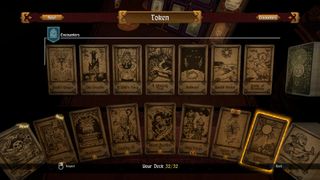
Choosing which encounter cards will have a chance to be dealt is incredibly important. Too many easy ones and you won't get enough equipment to beat the boss, but too many hard ones and you might not make it there at all.
Image 3 of 14

The 'Lost in Swamp' card was the bane of my existence when I was going after the Queen of Scales boss.
Image 4 of 14

These are the four possible options when you are faced with a choice. Many of the easier encounters are simply three Success cards and one Failure, and each outcome can have very different results.
Image 5 of 14

Blessings can be powerful buffs, but which ones you get are entirely random.
Image 6 of 14
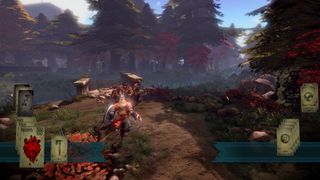
Don't be fooled by those piles of leaves, some fights are full of hidden traps.
Image 7 of 14
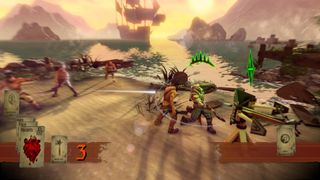
The lighting in some levels is really spectacular.
Image 8 of 14
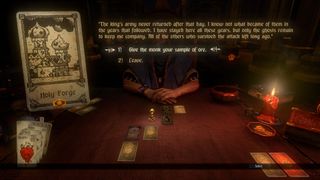
Although the battle environments are beautiful, you'll be spending most of your time reading text and staring at the dealer.
Image 9 of 14
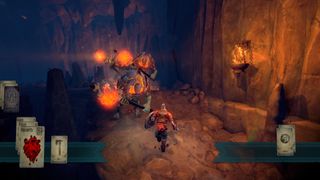
Lava Golems look menacing, but once you figure out their attack pattern, it's a matter of time instead of skill to kill them.
Image 10 of 14
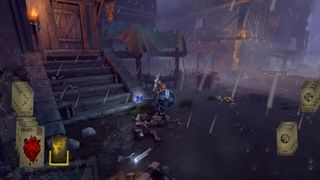
Each battle environment can also have different weather and take place at different times of day.
Image 11 of 14
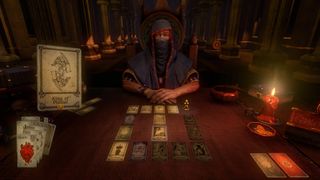
The harder levels have increasingly elaborate card layouts
Image 12 of 14
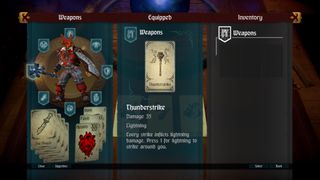
Each piece of equipment has a unique looks and visibly changes your character in combat.
Image 13 of 14

When you kill a boss, you claim its token as a reward and its card is added to the deck of enemies you might encounter in the future.
Image 14 of 14

Completing certain encounters for the first time will unlock new encounter and equipment cards to use.
Hand of Fate generally has problems with excess repetition. Repeating encounters again and again is meant to express the experience of reliving your character’s memories, but I soured on the device about two thirds of the way through the game. A few of the Dealer’s added cards are excessively punishing, and forced me to restart one level more times than I can remember. The 'Endless Mode' is free of these imbalances and was a welcome inclusion, but it doesn't add anything else to shake up the formula and grew old for me as well.
Hand of Fate becomes frustrating instead of challenging too often, but I still commend it for its unique mix of concepts, which works better than I had imagined. I was disappointed when the combat grew stale and I encountered the cruel 'Lost in Swamp' card for the twentieth time, because I wanted this inventive game to be fun throughout, but it eventually lost me. For the rest of it—I’d say my first seven hours—I enjoyed Hand of Fate for the difficult decisions it forced me to make and the fresh way it expressed its story through its systems. Not a huge failure at all, then, but ultimately a limited success.
The Verdict
Hand of Fate
A fun, unconventional RPG with interesting new ideas that arent entirely overshadowed by its repetitive nature and stale combat.
ABOUT THE AUTHOR Tom is PC Gamer’s Assistant Editor. He enjoys platformers, puzzles and puzzle-platformers. He also enjoys talking about PC games, which he now no longer does alone. Tune in every Tuesday at 1pm Pacific on Twitch.tv/pcgamer to see Tom host The PC Gamer Show.
We recommend By Zergnet
Post a Comment